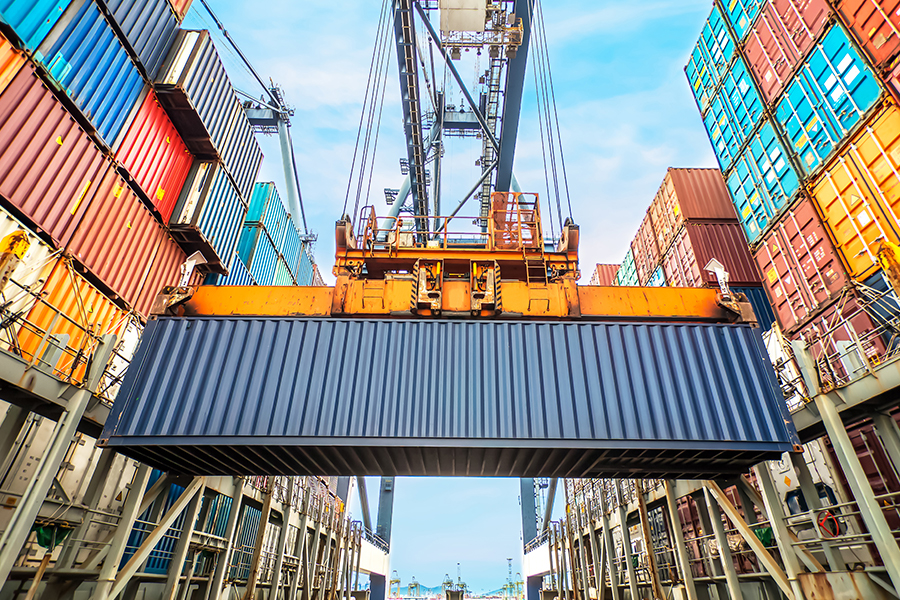Resources - Blog
Amazon FBA vs. Dropshipping: Which is Better in 2022?

As a growing seller on Amazon, there are many choices you need to make, one of them being how your orders will be fulfilled. Learn which fulfillment method is better, Amazon FBA or dropshipping.
Stay on top of the latest e-commerce and marketplace trends.
Deciding how your business will source, fulfill, and deliver products to your customers on Amazon can be challenging, especially in the current market with supply chain disruptions and inventory shortages. While the marketplace is full of e-commerce platform options, there are essentially two main avenues for fulfillment, dropshipping or Amazon FBA (Fulfillment By Amazon).
Both are designed to make selling items online cheaper and more manageable, allowing you to sell a larger variety of products and SKUs.
Each model offers pros and cons, but both will enable you to grow your e-commerce business without storing products, processing orders, or even stepping foot inside a shipping center. There are benefits and risks to both, so doing research like reading this blog will be essential for you to make an informed decision for your business. Read on to learn about the pros and cons of Amazon FBA and dropshipping as options for product fulfillment for your company.
Fees can add up, and your goal as a seller is to turn a profit. If you can calculate the expected payments and costs, that will help you keep your bottom line.
Option #1: Sell Through Amazon FBA
Amazon FBA Advantages
The rise of the pandemic brought with it many increasingly tricky challenges for sellers and retailers, including rising shipping costs, inventory and supply chain disruptions, and inflation. Many businesses have turned to Amazon to support these challenges due to their established and successful FBA services, including air and ground shipping.
Amazon is the largest e-commerce website globally, and nearly one out of every three homes in the U.S. has an Amazon Prime account. Customers visit Amazon daily, creating the perfect opportunity for sales and profits. Partnering with Amazon is believed to be the best and easiest option if you want to sell products online in 2022, proven by the fact that over 91% of Amazon sellers use FBA to fulfill some or all of their orders.
Further Reading: Amazon Seller Fees in 2022
To use Fulfillment by Amazon (FBA), businesses must ship their products to a fulfillment center and list the products on the main Amazon website. After an order is sold, Amazon will pack and ship the order from the warehouse to the customer. During this process, Amazon will handle customer service and returns that may be needed.
Amazon also has a structured returns process that, through the FBA, allows you to profit from Amazon’s free shipping and returns and helps prevent issues like return fraud. This is especially important for e-commerce businesses as online retailers have a return rate of over 20%, double the return rate of brick and mortar stores. By using Amazon FBA, sellers benefit from full-service back-end logistics that many growing businesses don’t have the infrastructure to handle.
Amazon FBA Drawbacks: Hands-Free Doesn’t Come Cheap
A downside to this “hands-off” approach is cost. There are fees for selling, storage fees, and other costs associated with returns. Amazon takes their seller fees off the top before depositing your earnings every two weeks. If you don’t make more than you owe, you are responsible for the balance.
This convenience comes at a cost, and due to the number of fees that can accrue, Amazon FBA is a better option if you are selling more expensive products. You will encounter fewer Amazon fees with dropshipping compared to Amazon FBA.
Amazon FBA and the Buy Box
You are in fierce competition with other sellers like you, so how can you stand out among the rest? Amazon’s Buy Box is the e-commerce platform’s answer to this question.
A Buy Box is featured on every product detail page displaying the ‘Add to Cart’ button that customers click to add items to their shopping carts. When one of your items appears as the default on the product page, you “win” the Buy Box, increasing your chances of selling that item. Amazon FBA sellers have perks with Amazon that dropshippers do not.
How does Amazon decide which seller’s product wins the Buy Box? Metrics, and lots of them. You can find all of the criteria located on your Account Health page.
You are automatically eligible to win the Buy Box as an FBA seller, as your FBA status increases your chances. However, there is no guarantee.
Further Reading: The 2022 Ultimate Amazon Buy Box Guide for Sellers and Retailers
As with any Amazon business, nothing is hassle-free, and there is no guaranteed success even with drop shipping.
Option #2: Dropshipping
Starting a new business can be costly, but one way to launch with lower startup costs is by using a dropship company. There are countless dropshippers on the market, so the first step is to find one that offers products you want to sell.
As soon as you create an account, they take care of production or procurement, inventory and storage, and shipping and delivery to the customer, usually at a lower cost than Amazon FBA. Be warned that many of the dropshipping benefits are generally more suited to advanced sellers. There are some disadvantages that can upend a new seller’s business.
Further Reading: How to Strategically Leverage Drop Shipping for Your Amazon Business
Dropshipping: The Hands-On E-Commerce Solution
While dropshipping sounds like a sure way to drive profits on Amazon, as with any Amazon business, nothing is hassle-free, and there is no guaranteed success even with drop shipping. Basing your Amazon business on dropshipping is difficult. When dropshipping, you are responsible for the following:
- Receiving the customer’s order
- Sending an order confirmation
- Forwarding every order to the dropshipper
Unlike Amazon FBA, dropshipping isn’t running 24/7 because you need to manually submit orders to the dropshipper. Offering free shipping to your customers gives you an edge, but you are responsible for covering shipping costs.
Free shipping is not the same as Prime shipping, which is unavailable to dropship sellers. This is one way Amazon encourages sellers to sign up with FBA rather than dropshipping.
Variables and Issues with Dropshipping
The online marketplace is highly competitive, due in part to the first glance simplicity of dropshipping and low start-up investment. You and your competition are vying for the same customers and sales, which can sometimes mean fighting to offer the product at the lowest possible price.
Competitive pricing is always important for sellers but even more so when buying from a dropshipping seller. This is because many are selling the same products as others, making it more challenging to stand out.
Learn About Feedvisor’s Patented Repricing Technology for Competitive FBA Sellers
So, Which Option Should You Choose?
Pros of Amazon FBA:
- Instant access to Amazon’s global audience
- Customer service is built-in
- Easy refund and returns service
- Far more significant profits are possible since you’re eligible to win the Buy Box
In Summary: With FBA, you get access to the Amazon Prime membership audience and branding, giving you a leg up on dropshipping competitors. Using FBA allows you to free up your time on storage, fulfillment, and customer service tasks, and for many, the FBA fees are worth it to take those tasks off their plate.
Cons of Amazon FBA:
- Higher costs associated with FBA storage and shipping fees, payable on every sale
- Higher startup costs to purchase stock upfront and send to Amazon FBA
- Product competition is fierce
In Summary: Costly recurring fees, lack of control with product handling, and higher return rates are all cons to using Amazon FBA. Though, Amazon’s FBA fees are worth it for many sellers since Amazon’s brand attracts a pre-existing audience and automates many steps of the process, including storage, packing, shipping, and returns. This is a double-edged sword as building your own email or audience list is difficult on a platform like Amazon, and there is less flexibility in switching out products if you have a low-performing SKU.
Pros of Dropshipping:
- Lower startup costs
- No upfront investment in products is required
- Lower risk since no capital needs to be invested
- Save time as your storage and shipping are handled
In Summary: Dropshipping is a smart method to expand your catalog and test new products, and can help you minimize overstock or out of stock risks. Unlike Amazon FBA, it is much easier to discontinue or switch out products. Dropshipping provides a hands-off approach with more control of your customer list.
Cons of Dropshipping:
- Responsible for shipping costs
- No chance of winning the Buy Box
- Smaller profit margins
In Summary: As a method for fulfillment, dropshipping has notable disadvantages for newer sellers. For established retailers with deeper catalogs, higher traffic, and more Amazon experience, dropshipping is much easier to navigate.
Ultimately, the decision is what is right for your business at the time. Make sure you consider seasonality, as the potential for sales and increased profit margins will vary depending on your launch.
Not every product offered on Amazon is discounted on Prime Day, but those in competitive industries know that Prime Day can make a huge difference.
Consider the Power of Prime Day
In recent years, especially since the global pandemic started in 2020, Amazon’s Prime Day has become one of the top shopping days of the year behind the Cyber 5 shopping weekend, including Black Friday and Cyber Monday.
Not every product offered on Amazon is discounted on Prime Day, but those in competitive industries know that Prime Day can make a huge difference. During the pandemic, countless businesses began selling on Amazon with FBA and dropshipping methods. This massive influx of sellers and products does not necessarily mean that the market is oversaturated, but staying on top can be challenging.
All-Access to Amazon Prime Day Perks
Amazon FBA sellers have an advantage over their dropshipping peers when it comes to Prime Day. Products are automatically eligible for Prime shipping as an FBA seller, and the catch is that only products eligible for Prime shipping qualify for Prime Day.
You can offer promotions and discounts for bundled items and easily create ads to promote your products. The same benefits are offered during peak holiday shopping events, giving Amazon FBA sellers an edge.
Final Thoughts
After considering all factors, make sure you treat the business seriously, whatever option you choose. Neither option is a set-it-and-forget-it opportunity. To win on Amazon in 2022, you’ll need to rise above the competition with a combination of a winning product and the right technology that can outpace your competition.
